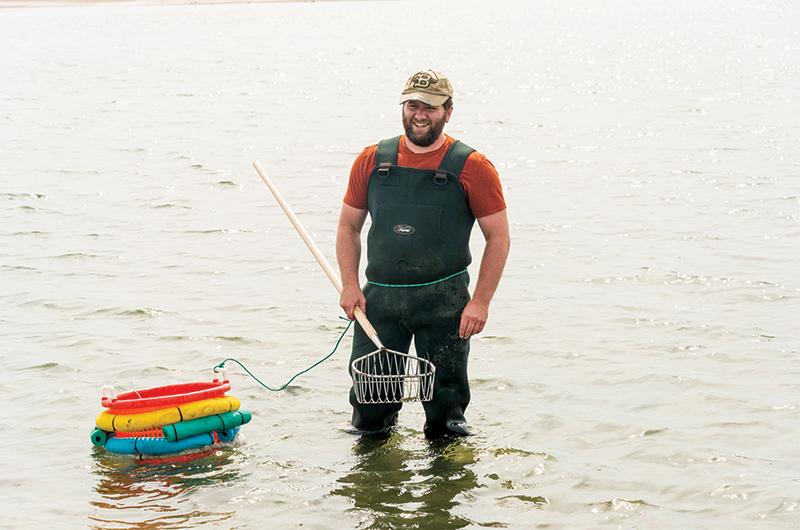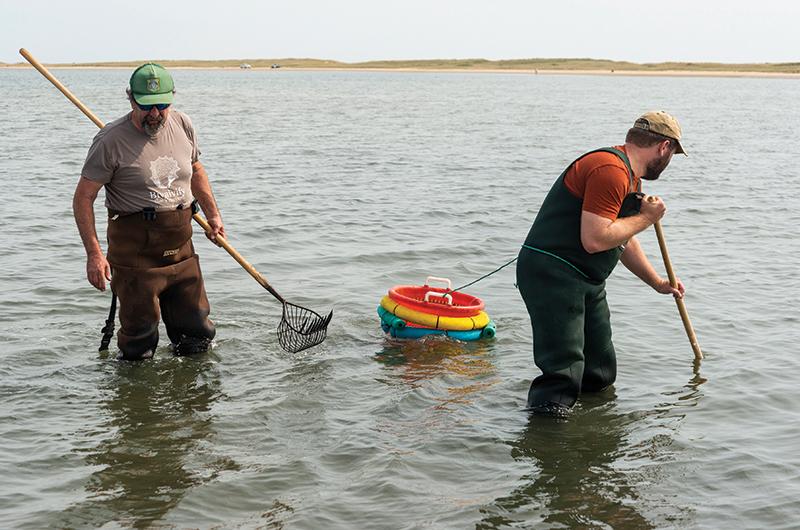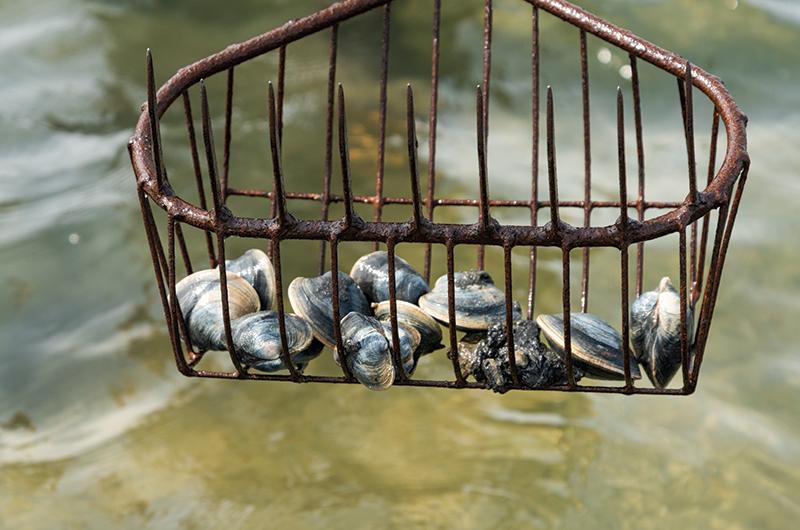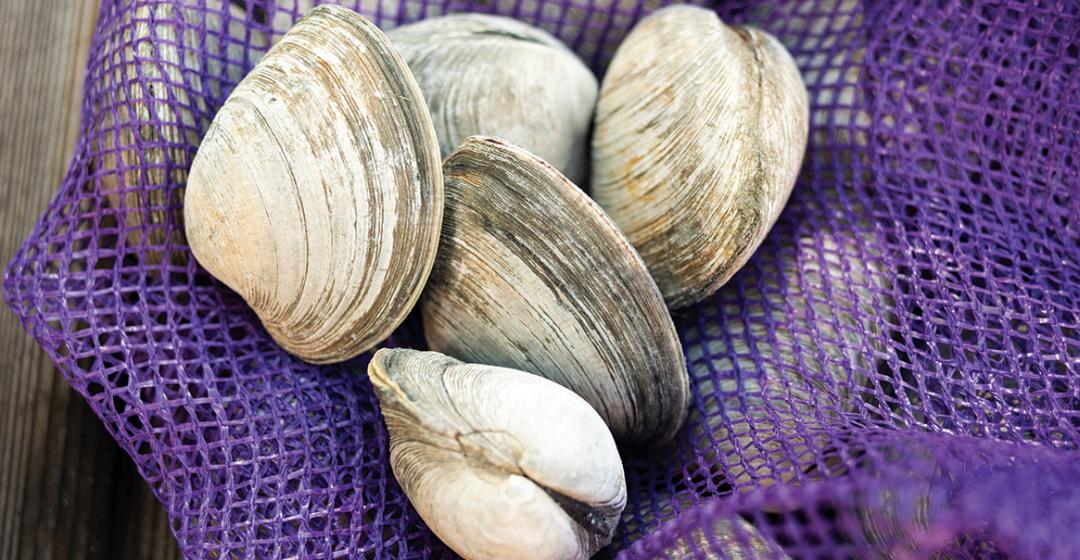It’s an August morning around 9 a.m., and it looks to be the start of a partially cloudy day for quahaugging in Katama Bay as I ready the small Zodiac with a floating basket, square measuring gauge, and scratch rake. My targets for the day are the big chowders – quahaugs over four inches measured across the widest part of the shell – that make good beds for my stuffed quahaug recipe, along with a few smaller two-inch littlenecks and four-inch cherrystones that are tasty and less tough than the big chowder “brights,” as clams with clean, attractive shells are known.
Even with the motor tipped up to keep the prop from scraping the bottom, it doesn’t take long to travel from the Katama boat ramp and reach a good clam spot for digging. Like most regulars, I’m headed for a favorite spot. I have plenty, having clammed with my family since childhood. But good beds aren’t hard to find if you know what you’re looking for, in part because the family area in Katama is supplemented with quahaug seed from the Martha’s Vineyard Shellfish Group. Generally speaking, you want to find a place that has a clean, sandy bottom. Quahaugs also grow in rocky areas, but are harder to dig there.
When I dig for quahaugs, I tend to drag the rake along the brown sand, kicking up clouds of inky black muck beneath, feeling for the satisfying scrape of the clam into my rake. It will feel like you are hitting a smooth rock, but as I rake an area I also probe with my bare foot in the spots I have already scratched with the rake. I can recall many times when I have stepped on a predator to the quahaug, such as a horseshoe crab or spider crab, but the additional clams you find with your toes are well worth the risk.

A quahaug starts out as “seed” and grows by filtering water through its open shell while digging through the sand with its foot muscle. The animal uses its two siphons to push the water first over its gills to extract oxygen and then into its gut to absorb and digest the algae on which it thrives. Quahaugs mature at around two inches, which takes three to four years. They can spawn one batch of 2.4 million eggs per year as they grow and may live up to about forty-five years.
It’s a good thing that quahaugs lay a lot of eggs because they live in a dangerous world. Green crabs, speckled lady crabs, and blue crabs, for example, begin feasting on quahaug seed as soon as it reaches about the size of a grain of rice. When quahaugs start to approach littleneck size – defined by having a one-inch hinge width – seagulls pick them up out of the water and drop them on a hard surface to get to their meat. Littlenecks, of course, are also the size when people can legally harvest them.
Every part of the quahaug other than the shell is consumable and full of rich nutrients, including zinc and magnesium. As far back as 10,000 years ago, Native Americans had perfected the art of extracting clams from the abundant clam beds in the area. They used the shells to craft wampum for decorative, status, and ceremonial uses. Wampum was also shared or traded with other Native Americans and eventually with the Europeans who arrived in the 1600s. The shells are still used for making jewelry by Wampanoag artists in Aquinnah and others, some of whom buy the shells of big brights that David “Dog” Berube harvests along with the littlenecks he sells to the Net Result in Vineyard Haven.
Berube, who got the nickname from Leo Willoughby because he works like a dog, has been scalloping every season for fifty years, beginning in 1971, when he and Steve Ewing got a boat and headed out for bay scallops in Cape Pogue. Shortly after, he got into quahaugging. “Back in the seventies, probably into the eighties, there was quite a fishery down at Katama,” he said. “There were thirty to forty guys quahaugging down there for mostly littlenecks.”

Over the next five decades the overall catch for quahaugs decreased, and with it the number of professional shellfishermen. My father, Paul Bagnall Sr. (who is currently the shellfish constable for Edgartown), quit commercially shellfishing out of Edgartown in 1984 when about 175 total commercial shellfishing licenses, including those for oysters and scallops, were issued annually by the town. Now that number is closer to fifty, and the number of persons who actually make their primary living from shellfishing as opposed to having it as a side gig is even lower. Not only is it harder to make the limit for littlenecks and cherrystones of two bushels, or about 800 clams, it’s harder to sell them when you do get them, especially since Edgartown’s last wholesale buyer closed in the 1990s. (The same goes for soft-shell clams and wild oysters; only bay scallops can reliably be sold for good prices.)
“When Katama Seafood folded, there was no place to have a home for me; [you’d] just go dig quahaugs and not know what to do with them,” said Berube. “Right now, its Danny Tilton, Steve Kuehne, and me. I think it’s the three of us in Edgartown, and that’s all [the quahauggers] left.”
The reasons for the decline in quahaug catch are not fully understood, though overfishing is not generally believed to be an important factor. The opening and closing of the breach in the barrier beach at Norton Point may play a role in the apparently cyclical nature of quahaug seed production and success. The breach opened in 1953 and closed in 1969, reopened for a year in 1976, then reopened again in 2007 before closing in 2015. The remarkable growth of the commercial oyster farming industry in the bay in the past few decades also may have lured away shellfishermen who otherwise would be clamming, and in fact has closed some areas to clamming. Since 1986 the Martha’s Vineyard Shellfish Group has been augmenting the natural supply of quahaug seed, especially in the areas designated for permitted recreational clammers only. There the family limit is a half bushel, or about 200 littlenecks. These days neither the commercial nor family quahauggers reach that limit on most expeditions. But I’m not looking for my limit, I’m just looking for dinner. Clamming in Katama Bay takes me around an hour and a half to catch just under fifty quahaugs.
That is, if I don’t eat too many of them on the job. While out there, I like to eat a couple from my catch because it beats bringing extra food with you and keeps my energy up for more raking. After opening the quahaug, I empty the salt water, knock the shell back like you would a shot of vodka, and wash it down with a slug from my bottle of water.
The quahaugs are very salty, but rich – at least that’s how I describe them.

Quahaug permit, gear, and shucking techniques
Shellfishing permits can be purchased at town hall. In Edgartown, the cost is $50 for residents and $250 for non-residents. Residents over the age of sixty get their permits for free.
Quahaugging gear includes a scratch rake, floating basket, and square gauge to measure the quahaugs. If the quahaug falls through the gauge, it is too small to keep and should be thrown back into the water. A bull rake is a larger version of a scratch rake with a big handle to drag a trench. It can be used to bring up multiple quahaugs at the same time. Commercial shellfishermen typically like to use bull rakes.
Quahaugs can be a bit stubborn to crack open, though they get easier with practice. Putting them on ice in a cooler overnight will put them to “sleep” – they partially open their shells after their muscles have been relaxed. Submerging them in boiling water will also open them. Quahaugs can be shucked whether they’re open or closed, however closed is a bit harder. If the shell is too stubborn to slip a knife between, you can press the blade behind the hinge of the quahaug and rock the clam back and forth to break the ligament – or the back – to tease the clam open. Once in, get the knife into the right side of the quahaug and quickly slide it along the foot in one movement.
The following recipes were originally published along with this article:





